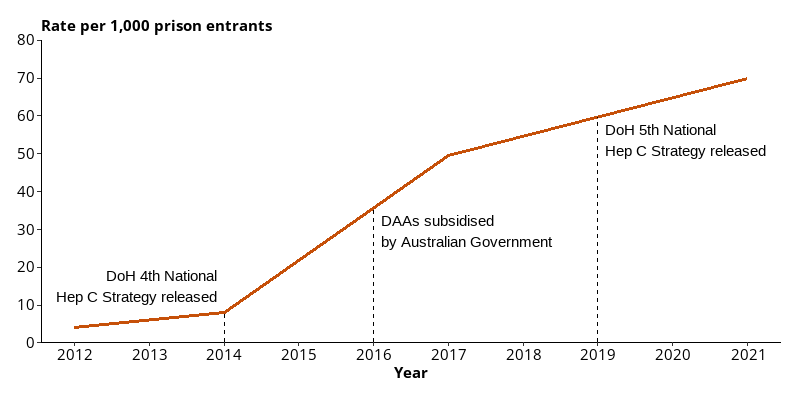Hepatitis C treatment
The Department of Health and Aged Care has outlined strategies to eliminate hepatitis C as a public health threat by 2030 (Department of Health and Aged Care 2023).
From March 2016, direct-acting antivirals were subsidised by the Australian Government, leading to a much higher uptake of hepatitis C treatment in Australia – and in priority groups such as the prison population (Department of Health and Aged Care 2023).
Direct-acting antivirals replaced the interferon-based treatments for hepatitis C infection, and are shorter in course duration, more effective and have fewer side effects for patients (Lafferty et al. 2018).
The Department of Health and Aged Care’s Sixth National Hepatitis C Strategy 2023–2030 reports that Australian prisons, currently, do not offer regulated access to sterile injecting equipment, despite prisons being primary settings of hepatitis C transmission. Subsequent National Hepatitis C Strategies should prioritise actions to respond to this unmet need (Department of Health and Aged Care 2023).
People in prison remain a priority group for testing and treating hepatitis C, and diagnoses and treatments need to be accompanied by education and support.
The introduction of direct-acting antivirals to treat hepatitis C has been revolutionary in the prison population. Before these were available, the rate of uptake of hepatitis C treatment was 4 courses of treatment per 1,000 people received into custody in 2012, 8 courses of treatment per 1,000 in 2014, and 50 courses of treatment per 1,000 received into custody in 2017 (Figure 12.5).
In 2021, the rate of hepatitis C treatment was 70 courses of treatment per 1,000 people received into custody (Indicator 3.3.5).
For more information on Hepatitis C, see Communicable diseases.
Figure 12.5: Trends in hepatitis C treatment courses per 1,000 people received into prison, by year, 2012–2021

DAA = Direct-acting antiviral agents; DoH = Department of Health; hep = hepatitis.
Notes
- Rates of hepatitis C treatment courses are representative of this data collection and not the entire prison population.
- The Department of Health 4th (2014–2017), 5th (2018–2022) and 6th (2023–2030; not shown on graph) National Hepatitis C Strategy identifies the prison population as a priority group.
Source: Establishment form, NPHDC 2012, 2015, 2018, 2022.
DHAC (Department of Health and Aged Care) (2023) Sixth National Hepatitis C Strategy 2023–2030, Department of Health and Aged Care, accessed 15 August 2023.
Lafferty L, Wild TC, Rance J and Treloar C (2018) ‘A policy analysis exploring hepatitis C risk, prevention, testing, treatment and reinfection within Australia’s prisons’, Harm Reduction Journal, 15:39, doi:10.1186/s12954–018–0246–6.


